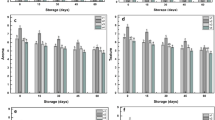Summary
Radiophosphorus concentration in localized areas of potato tuber slices is well correlated with the color of chips in those areas. High radiophosphorus concentration is associated with light color chips while low radiophosphorus concentration is associated with dark color chips. However, the simple correlation coefficient between radiophosphorus and chip color is very low and not significant. Total phosphorus content was higher in areas of tubers that produced light chip color than in areas which fried dark. The simple correlation coefficient between total phosphorus and chip color comes close to being significant at the 5% level.
The amount of P-32 found in given portions of potatoes is consistently, inversely proportional to the amount of reducing sugars found in those portions of potatoes.
The multiple correlation coefficient for chip color versus reducing sugars plus total sugar plus sucrose plus total phosphorus plus inorganic phosphorus plus radiophosphorus for potatoes obtained from Experiment 2, was found to be r=.988 and significant at the 5% level.
Simple correlation coefficients between reducing sugars, total sugar and sucrose versus chip color, were all significant at the 1% level.
It is highly probable that phosphorylated monosaccharides per se, have no effect on the browning reaction in potato chips owing to their intrinsically low concentration in fresh potatoes. Compared with reducing sugars in model systems, certain hexose phosphates gave much lighter colors to fried filter papers and fresh or frozen slices of a well-conditioned Merrimack potato when the concentration of each solute in various dipping solutions was 0.1 molar.
Resumen
La concentración de radiofósforo en las areas localizadas de las rebanadas de tubérculo de papa, se correlaciona bien con el color de las hojuelas en aquellas areas. La alta concentración de radiofósforo, está asociada con el color claro de las hojuelas, mientras que la baja concentración de radiofósforo, está asociada con el color oscuro de las hojuelas. Sin embargo, el coeficiente de correlación simple entre radiofósforo y color de hojuelas, es muy bajo y no es significativo. El contenido total de fósforo fue más alto en las areas de los tubérculos que produjeron hojuelas de color claro, que en las areas e las cuales fueron fritas hasta tomar un color oscuro. Aunque sin ser significativo, el coeficiente de correlación simple entre ei total de fósforo y color de las hojuelas, se asproxima a ser significativo al 5%.
La cantidad de P-32 encontrada en porciones dadas de las papas, es consistente, inversamente proporcional a la cantidad de azúcares reducidas, encontradas en aquellas porciones de papa.
El coeficiente de correlación múltiple, para el color de hojuelas contra azúcares reducidas, más total de azucar, más sucrosa, más total de fósforo, más fósforo inorgánico, más radiofósforo para la papa obtenida del Experimento 2, se encontró que r=.988 y significativo al nivel de 5%.
Los coeficientes de correlación simple entre los azúcares reducidos, azucar total y sucrosa, contra el color de las hojuelas, fueron todos significativos al nivel de 1%.
Es altamente probable que los monosacáridos fosforilados, no tienen efecto en la reacción de oscurecimiento en las hojuelas de papa, debido a la baja concentración, intrinsicamente, en papa fresca. En la comparación con las azúcares reducidas en el sistema modelo, ciertos fosfatos de hexosa dieron colores más claros a los filtros de papel de freido y las rebanadas frescas o congeladas, de papa Merrimack bien condicionada. cuando la concentración de cada soluto en varias soluciones de inmersión fue de 0.1 molar.
Similar content being viewed by others
Literature Cited
Hart, T. G. 1965. The influence of phosphorus and potassium nutrition on the processing quality of chipping potatoes (Solanum tuberosum L.) Ph.D. Thesis. Cornell University.
Hart, T. G. and Ora Smith. 1963. Potato Quality XIX: A preliminary study of the browning reaction in potato chips using radiophosphorus. Amer. Potato J. 40: 421–429.
Kitson, R. E. and M. C. Mellon. 1944. Colorimetric determination of phosphorus as molybdivanado-phosphoric acid. Industrial and Engineering Chemistry (Analytical Chemistry (Analytical Edition). 16: 379–383.
Mori, K., M. Nakamura and S. Funahashi. 1960. Fractionation of sugars, phosphates and nucleotides in potato tubers by ion exchange chromatography. Bull. Agr. Chem. Soc. Japan 24: 344–350.
Schwimmer, S. and H. S. Olcott. 1953. Reaction between glycine and the hexose phosphates. J. Amer. Chem. Soc. 75: 4855–4856.
Schwimmer, S., A. Bevenue and W. J. Weston. 1955. Phosphorus components of the white potato. J. Agr. and Food Chem. 3: 257–260.
Smith, Ora, T. G. Hart, and C. O. Davis. 1963. Improving color of chips from potatoes held at low temperatures. Proc. Thirteenth Natl. Potato Utiliz. Conf. 13:26.
Sumner, J. B. 1925. A more specific reagent for the determination of sugar in urine. J. Biol. Chem. 65: 393–395.
Wright, B. C. 1959. Investigations of phosphate reaction products in acid soils by the application of solubility criteria. Ph.D. Thesis. Cornell University.
Author information
Authors and Affiliations
Additional information
Paper No. 537, Department of Vegetable Crops, Cornell University, Ithaca, New York.
Formerly Graduate Assistant, Department of Vegetable Crops, Cornell University.
Rights and permissions
About this article
Cite this article
Hart, T.G., Smith, O. Potato quality XXVII: Investigations on the role of phosphorus in potato chip browning. American Potato Journal 43, 158–172 (1966). https://doi.org/10.1007/BF02861643
Accepted:
Issue Date:
DOI: https://doi.org/10.1007/BF02861643




